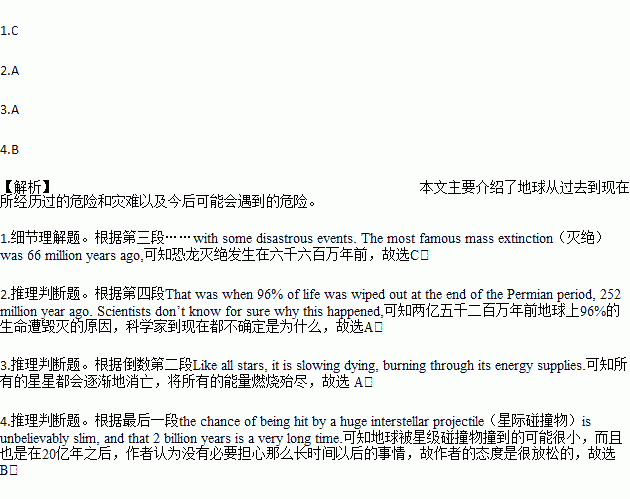题目内容
Dangers from Outer Space
What is the greatest threat to life on our planet? Is it climate change? Shortages of food or water? Or might an altogether bigger danger come from somewhere further away: space?
We’re not talking about an attack by little green men here. Instead, how about being hit by a large falling star, beat by deadly universal rays or fried by the energy of an erupting star?
It wouldn’t be the first time that our Earth has had a rough ride over the last 3.7 billion years, with some disastrous events. The most famous mass extinction(灭绝)was 66 million years ago, when it’s widely believed that a meteorite(陨石)killed off the dinosaurs. A 110-mile-wide crater in Mexico with the same geological age supports this theory.
Believe it or not, this wasn’t the worst catastrophe in our planet’s history. That was when 96% of life was wiped out at the end of the Permian period, 252 million year ago. Scientists don’t know for sure why this happened, but any potential explanations carry with them the possibility that similar events could happen again.
Some experts believe that our Sun has a twin star which is too far away to observe directly. This huge sleeping star could twist the paths of orbiting icy rocks and cast them towards the rest of the Solar System.
Is this what happened 252 million years ago? Or is there instead, perhaps, a distant, ninth plant in our Solar System which pulls in passing comets(彗星)and sends them dashing our way?
The Sun that has given us the warmth is gradually turning into a deadly enemy. Like all stars, it is slowing dying, burning through its energy supplies. As it does so, it expands, and in about 2 billion years it will have grown so much that the heat will make life on planet Earth unbearable.
While all this sounds a little horrible, take comfort from the fact that the chance of being hit by a huge interstellar projectile(星际碰撞物)is unbelievably slim, and that 2 billion years is a very long time.
1.When did dinosaurs die out according to the passage?
A. 3.7 billion years ago. B. 252 million years ago.
C. 66 million years ago. D. 2 billion years ago.
2.Why was 96% of life destroyed at the end of the Permian period?
A. The cause is still unknown.
B. A huge falling star hit the earth.
C. A twin star cast icy rocks towards the Solar System.
D. A ninth planet pulled in passing comets.
3.What can we learn from the passage?
A. All stars will eventually run of energy.
B. Our planet will be attacked by little green men.
C. We will be fried by the energy of an erupting star.
D. A huge sleeping star will hit the earth in millions of years.
4.What is the author’s attitude toward the dangers from outer space?
A. Frightened. B. Relieved.
C. Worried. D. Doubtful.
 字词句篇与同步作文达标系列答案
字词句篇与同步作文达标系列答案
